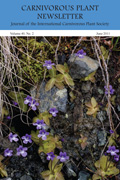International Carnivorous Plant Society
Carnivorous Plant Newsletter Archive
Fluorescence tagging of phosphatase and chitinase activity on different structures of Utricularia traps
Lubomír Adamec and Jaroslav Vrba and Dagmara Sirova
Carniv. Pl. Newslett. 40(2):68-73
Published 1 June 2011
https://doi.org/10.55360/cpn402.la656
Abstract
The genus Utricularia (Lentibulariaceae) comprises about 220 species and represents the largest genus of carnivorous plants (Taylor 1989; Guisande et al. 2007). The trap of Utricularia is a hollow utricle usually 1-4 mm long, with walls mostly two cells thick, and filled with water. It is the most sophisticated trap within carnivorous plants (Juniper et al. 1989), with a variety of glands and trichomes both on the inner and outer surfaces (see Figure 1). After the prey irritates trigger hairs situated close to the trap door, it is sucked in as a result of the underpressure maintained inside the utricle. After firing, the trap restores the underpressure by rapidly removing approximately 40% of the water from the lumen. This process lasts about 30 min and the trap is ready to fire again (Sydenham & Findlay 1975).
Keywords: physiology, Utricularia, chemistry, digestive enzymes
Article Citation
Lubomír Adamec and Jaroslav Vrba and Dagmara Sirova. 2011. Fluorescence tagging of phosphatase and chitinase activity on different structures of Utricularia traps. Carniv. Pl. Newslett. 40(2):68-73. https://doi.org/10.55360/cpn402.la656
Page views: 901
©2025 International Carnivorous Plant Society
www.carnivorousplants.org
This page is maintained by John Brittnacher.
Please contact us at our membership website, icps.clubexpress.com.
Privacy: The Carnivorous Plant Newsletter Archive website does not track users.

